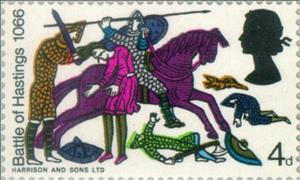Stamp: Battle Scene from the Bayeux Tapestry V (United Kingdom of Great Britain & Northern Ireland 1966)
Battle Scene from the Bayeux Tapestry V (United Kingdom of Great Britain & Northern Ireland 1966)
14 October (United Kingdom of Great Britain & Northern Ireland ) within release Battle of Hastings goes into circulation Stamp Battle Scene from the Bayeux Tapestry V face value 4 British penny (old)
| Stamp Battle Scene from the Bayeux Tapestry V in catalogues | |
|---|---|
| Stanley Gibbons: | Sg: GB 709Wi |
Stamp is square format.
Printed by HarrisonAlso in the issue Battle of Hastings:
- Stamp - Battle Scene from the Bayeux Tapestry V (phosphor) face value 4;
- Stamp - Battle Scene from the Bayeux Tapestry VI face value 4;
- Stamp - Battle Scene from the Bayeux Tapestry VI (phosphor) face value 4;
- Stamp - Battle Scene from the Bayeux Tapestry I face value 4;
- Stamp - Battle Scene from the Bayeux Tapestry I (phosphor) face value 4;
- Stamp - Battle Scene from the Bayeux Tapestry II face value 4;
- Stamp - Battle Scene from the Bayeux Tapestry II (phosphor) face value 4;
- Stamp - Battle Scene from the Bayeux Tapestry III face value 4;
- Stamp - Norman Ship (phosphor) face value 6;
- Stamp - Norman Horsemen attacking Harold's Troops face value 1'3;
- Stamp - Norman Horsemen attacking Harold's Troops (phosphor) face value 1'3;
- Stamp - Battle Scene from the Bayeux Tapestry IV face value 4;
- Stamp - Battle Scenes from the Bayeux Tapestry IV (phosphor) face value 4;
- Stamp - Battle Scene from the Bayeux Tapestry V face value 4;
- Stamp - Norman Horsemen attacking Harold's Troops (Phosphor) face value 1'3;
- Stamp - Battle Scene from the Bayeux Tapestry II face value 4;
- Se-tenant - Battle Scenes from the Bayeux Tapestry face value 6*4;
- Se-tenant - Battle Scenes from the Bayeux Tapestry face value 6*4;
- Stamp - Battle Scene from the Bayeux Tapestry III face value 4;
- Stamp - Battle Scene from the Bayeux Tapestry III (phosphor) face value 4;
- Stamp - Norman Ship face value 6;
- Stamp - Battle Scene from the Bayeux Tapestry V (phosphor) face value 4;
- Stamp - Battle Scenes from the Bayeux Tapestry IV face value 4;
- Stamp - Norman Horsemen attacking Harold's Troops face value 1'3;
- Stamp - Battle Scene from the Bayeux Tapestry VI face value 4;
- Se-tenant - Battle Scenes from the Bayeux Tapestry (Phosphor) face value 6*4;
- Stamp - Battle Scene from the Bayeux Tapestry II (phosphor) face value 4;
- Se-tenant - Battle Scenes from the Bayeux Tapestry (Phosphor) face value 6*4;
- Stamp - Battle Scenes from the Bayeux Tapestry IV (phosphor) face value 4;
- Stamp - Battle Scene from the Bayeux Tapestry VI (phosphor) face value 4;
- Stamp - Battle Scene from the Bayeux Tapestry I face value 4;
- Stamp - Norman Ship (phosphor) face value 6;
- Stamp - Battle Scene from the Bayeux Tapestry V face value 4;
- Stamp - Battle Scene from the Bayeux Tapestry I (phosphor) face value 4;
Stamp Battle Scene from the Bayeux Tapestry V it reflects the thematic directions:
Animals are multicellular, eukaryotic organisms of the kingdom Animalia (also called Metazoa). All animals are motile, meaning they can move spontaneously and independently, at some point in their lives. Their body plan eventually becomes fixed as they develop, although some undergo a process of metamorphosis later on in their lives. All animals are heterotrophs: they must ingest other organisms or their products for sustenance.
An anniversary is the date on which an event took place or an institution was founded in a previous year, and may also refer to the commemoration or celebration of that event. For example, the first event is the initial occurrence or, if planned, the inaugural of the event. One year later would be the first anniversary of that event. The word was first used for Catholic feasts to commemorate saints. Most countries celebrate national anniversaries, typically called national days. These could be the date of independence of the nation or the adoption of a new constitution or form of government. The important dates in a sitting monarch's reign may also be commemorated, an event often referred to as a "Jubilee".
Commemorations are a type of religious observance in the many Churches of the Anglican Communion, including the Church of England. They are the least significant type of observance, the others being Principal Feasts, Principal Holy Days, Festivals, and Lesser Festivals. Whereas Principal Feasts must be celebrated, it is not obligatory to observe Commemorations. They are always attached to a calendar date, and are not observed if they fall on a Sunday, in Holy Week, or in Easter Week. In Common Worship Commemorations are not provided with collects or indications of liturgical colour. However, they may be celebrated as Lesser Festivals if local pastoral conditions suggest it.
The horse (Equus ferus caballus) is one of two extant subspecies of Equus ferus. It is an odd-toed ungulate mammal belonging to the taxonomic family Equidae. The horse has evolved over the past 45 to 55 million years from a small multi-toed creature, Eohippus, into the large, single-toed animal of today. Humans began to domesticate horses around 4000 BC, and their domestication is believed to have been widespread by 3000 BC. Horses in the subspecies caballus are domesticated, although some domesticated populations live in the wild as feral horses. These feral populations are not true wild horses, as this term is used to describe horses that have never been domesticated, such as the endangered Przewalski's horse, a separate subspecies, and the only remaining true wild horse. There is an extensive, specialized vocabulary used to describe equine-related concepts, covering everything from anatomy to life stages, size, colors, markings, breeds, locomotion, and behavior.
Mammals are any vertebrates within the class Mammalia (/məˈmeɪli.ə/ from Latin mamma "breast"), a clade of endothermic amniotes distinguished from reptiles (including birds) by the possession of a neocortex (a region of the brain), hair, three middle ear bones and mammary glands. All female mammals nurse their young with milk, secreted from the mammary glands. Mammals include the largest animals on the planet, the great whales. The basic body type is a terrestrial quadruped, but some mammals are adapted for life at sea, in the air, in trees, underground or on two legs. The largest group of mammals, the placentals, have a placenta, which enables the feeding of the fetus during gestation. Mammals range in size from the 30–40 mm (1.2–1.6 in) bumblebee bat to the 30-meter (98 ft) blue whale. With the exception of the five species of monotreme (egg-laying mammals), all modern mammals give birth to live young. Most mammals, including the six most species-rich orders, belong to the placental group. The largest orders are the rodents, bats and Soricomorpha (shrews and allies). The next three biggest orders, depending on the biological classification scheme used, are the Primates (apes and monkeys), the Cetartiodactyla (whales and even-toed ungulates), and the Carnivora (cats, dogs, seals, and allies).
Textile is an umbrella term that includes various fiber-based materials, including fibers, yarns, filaments, threads, and different types of fabric. At first, the word "textiles" only referred to woven fabrics.However, weaving is not the only manufacturing method, and many other methods were later developed to form textile structures based on their intended use. Knitting and non-woven are other popular types of fabric manufacturing. In the contemporary world, textiles satisfy the material needs for versatile applications, from simple daily clothing to bulletproof jackets, spacesuits, and doctor's gowns






